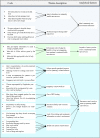Community perspectives: An exploration of potential barriers to men's involvement in maternity care in a central Tanzanian community
- PMID: 32437360
- PMCID: PMC7241761
- DOI: 10.1371/journal.pone.0232939
Community perspectives: An exploration of potential barriers to men's involvement in maternity care in a central Tanzanian community
Abstract
Background: Male involvement in maternal health has been linked to positive health outcomes for women and children, as they control household resources and make significant decisions, which influence maternal health. Despite of the important role they have in maternal health care, their actual involvement remains low. The objective of this study was to explore community perspectives on potential barriers to men's involvement in maternity care in central Tanzania.
Methods: Qualitative research methods were used in data collection. We conducted 32 focus group discussions (16 FGDs with men and 16 FGDs with women) and 34 in-depth interviews with community leaders, village health workers and health care providers. Interview guides were used to guide the focus group discussions and in-depth interviews. The interviews and discussions were audio recorded, transcribed and translated into English and imported into QSR NVivo 9 software for thematic analysis. Three themes emerged from the data; men's maternity care involvement indicators, benefits of men's involvement in maternity health care services and barriers to men's involvement in maternity health care services.
Results: Both men and women participants acknowledged the importance of men's involvement in maternity health care services, even though few men actually got involved. Identified benefits of men's involvement in maternity health care services include: Learning any risk factors directly from the health care providers and getting prepared in addressing them; and reinforcing adherence to instruction received from the health care provider as family protectors and guardians. Barriers to men's involvement in maternity health care services are systemic; starting from the family, health care and culture-specific gender norms for maternity related behaviour as well as healthcare facilities structural constrains inhibiting implementation of couple-friendly maternity health care services.
Conclusions: Men's involvement in maternity care is influenced by culture-specific maternity-related gender norms. This situation is compounded by the conditions of deprivation that deny women access to resources with which they could find alternative support during pregnancy. Moreover, structures meant for maternal health care services lack privacy, thus inhibiting male partners' presence in the delivery room. Intervention to increase men's involvement in maternity care should address individual and systemic barriers to men's involvement.
Conflict of interest statement
The authors have declared that no competing interest exist.
Figures
Similar articles
-
'What men don't know can hurt women's health': a qualitative study of the barriers to and opportunities for men's involvement in maternal healthcare in Ghana.Reprod Health. 2015 Oct 10;12:93. doi: 10.1186/s12978-015-0083-y. Reprod Health. 2015. PMID: 26452546 Free PMC article.
-
"I came to escort someone": Men's experiences of antenatal care services in urban Ghana-a qualitative study.Reprod Health. 2021 May 26;18(1):106. doi: 10.1186/s12978-021-01152-5. Reprod Health. 2021. PMID: 34039342 Free PMC article.
-
Men's perception of barriers to women's use and access of skilled pregnancy care in rural Nigeria: a qualitative study.Reprod Health. 2019 Jun 21;16(1):86. doi: 10.1186/s12978-019-0752-3. Reprod Health. 2019. PMID: 31227010 Free PMC article.
-
Men's involvement in maternal health in sub-Saharan Africa: A scoping review of enablers and barriers.Midwifery. 2024 Jun;133:103993. doi: 10.1016/j.midw.2024.103993. Epub 2024 Apr 7. Midwifery. 2024. PMID: 38626505
-
Men's experiences of antenatal care services in low-income and middle-income countries: A qualitative systematic review.Birth. 2023 Jun;50(2):276-286. doi: 10.1111/birt.12688. Epub 2022 Oct 30. Birth. 2023. PMID: 36309934
Cited by
-
Male partner involvement in postnatal care service utilization and its associated factors in Wolaita Sodo, southern Ethiopia, 2023.Front Glob Womens Health. 2025 Feb 18;6:1481164. doi: 10.3389/fgwh.2025.1481164. eCollection 2025. Front Glob Womens Health. 2025. PMID: 40041927 Free PMC article.
-
Fathers' involvement in pregnancy and childbirth in Africa: an integrative systematic review.Glob Health Action. 2024 Dec 31;17(1):2372906. doi: 10.1080/16549716.2024.2372906. Epub 2024 Jul 12. Glob Health Action. 2024. PMID: 38993149 Free PMC article.
-
Effects of the maternal and child health handbook and other home-based records on mothers' non-health outcomes: a systematic review.BMJ Open. 2022 Jun 21;12(6):e058155. doi: 10.1136/bmjopen-2021-058155. BMJ Open. 2022. PMID: 35728908 Free PMC article.
-
Prevalence and barriers to male involvement in antenatal care in Dar es Salaam, Tanzania: A facility-based mixed-methods study.PLoS One. 2022 Aug 19;17(8):e0273316. doi: 10.1371/journal.pone.0273316. eCollection 2022. PLoS One. 2022. PMID: 35984819 Free PMC article.
-
Understanding male involvement in antenatal care in the Kilimanjaro region of Tanzania: Barriers, facilitators, and opportunities for engagement.Sex Reprod Healthc. 2024 Mar;39:100931. doi: 10.1016/j.srhc.2023.100931. Epub 2023 Nov 24. Sex Reprod Healthc. 2024. PMID: 38039661 Free PMC article.
References
-
- Lincetto O, Seipati MA, Gomez P, et al. Antenatal care In: Lawn J, Kerber K, editors. Opportunities for Africa's newborns: practical data, policy and programmatic support for newborn Care in Africa. Geneva: WHO; 2006. p. 51–66.
MeSH terms
LinkOut - more resources
Full Text Sources
Medical


